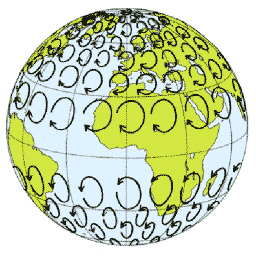State the units to describe wind speed
Wind is reported in knots (nautical miles per hour) and in degrees True when issued from Metservice
All wind directions used in aviation state the direction from which the wind is coming from
State the units to describe wind speed
Wind is reported in knots (nautical miles per hour) and in degrees True when issued from Metservice
All wind directions used in aviation state the direction from which the wind is coming from
State the effect of wind speed on the strength of the Coriolis force.
If the earth were stationary the wind would be able to move directly from high pressure to low pressure (just like a bicycle tube) which would mean that the wind blows at right angles across the isobars from the centre of the high to the centre of the low.
But as the earth rotates 360 degrees in 24 hours, the consequence of this is that the wind is prevented from blowing from high to low – and instead blows parallel with the isobars

Flow pictured for northern hemisphere
List the three forces acting to generate wind at low levels
The three forces are;
1. Pressure Gradient
2. Coriolis Force
3. Friction
State the units used to describe wind direction with reference to a) forecasts issued by Metservice and b) spot winds relayed to pilots
a) Forecasts issued by Metservice
The aviation industry uses Magnetic wind directions, but observed and forecasts winds issued from Metservice are provided in degrees True. This is because meteorological data often covers large areas in which the Magnetic North changes significantly
b) Spot winds relayed to pilots by Air Traffic Control
Spot winds are supplied in degrees Magnetic, – however if they are passing you a wind from a METAR and or TAF the direction will be issued in degrees True
Define the “geostrophic wind”
The geostrophic wind is the wind that would result from a perfect balance of Pressure Gradient, and Coriolis Force when the isobars are straight.
Because the surface frictional force is not involved in the definition, the wind balance represents the real wind found above the friction layer wherever there are straight isobars drawn on a weather map.
The resultant wind flows parallel to the isobars and wind speed is controlled by the magnitude of the Pressure Gradient
List the three properties of the Coriolis force
1) It act at right angles and to the left of motion in the Southern Hemisphere’
2) It’s strength is proportional to the wind speed – the stronger the wind the stronger the Coriolis force
3) Its strength is proportional to the sine of the latitude – zero at equator and max strength at the poles
Explain the cause of the Coriolis force
Coriolis force is caused by rotation of the earth. Any object in motion relative to the rotating frame of reference will deflect to the left in the Southern hemisphere
Coriolis is not a real force – more an apparent force – known as the Coriolis Effect
Measurement of the standard surface wind
Standard surface wind as stated in aviation observations and forecasts, is measured at the top of a 10 metre mast and averaged out over a 10 minute period
State the direction in which the following two forces act: a) pressure gradient; b) Coriolis force.
a) Pressure gradient is a force which always acts at right angles to the isobars and always from high to low
b) Under the influence of the Coriolis force the movement of air from high to low pressure is prevented from doing so and is deflected to the Left in the Southern hemisphere


Describe how stable and unstable air affect flying conditions.
Stable air with high moisture
Produces stratiform cloud or fog; bad conditions for VFR flying
Less moisture content -> cloud bases are higher -> visibility may be unsafe if associated with rain or drizzle
Unstable air
Produces cumuliform cloud – if closely spaced and shower activity is present; unsuitable for VFR flight
When less moist, cloud bases will be higher, cumulus clouds wider apart visibility should be good, light turbulence possible but conditions generally good for VFR flight